The Secrets of High-Performing Online Content
- Fahad H

- May 1, 2018
- 7 min read
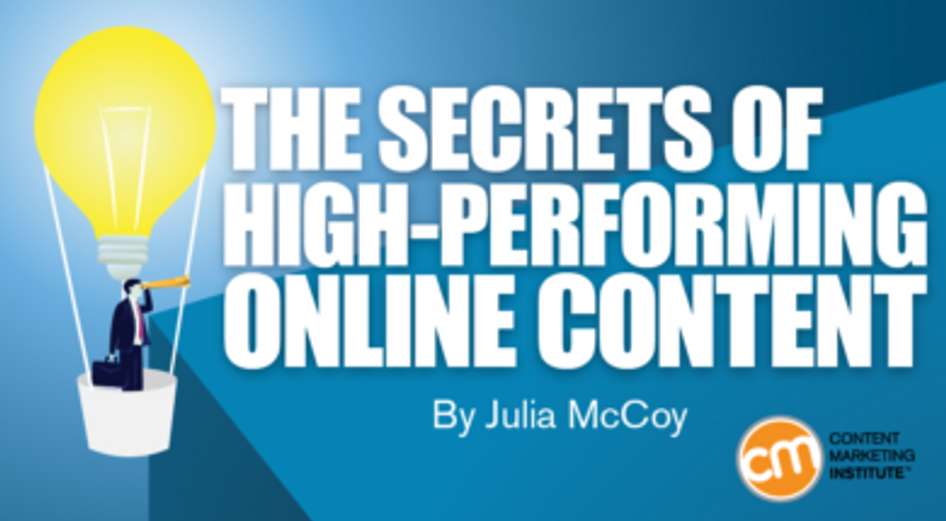
Good content is one thing, but great online content is another.
How do you define great content? Yes, it should be well-written, addictively readable, and hit home for its intended audience.
But it should also convert like crazy. After all, that’s the point of content creation for us, the marketers.
The good news is that content that is high-performing for us is useful for them, our readers. To reach this win-win, let’s look at what you can do to take your content from good to great, from “just OK” to high-powered, high-performing, and massively successful.
1. Use keywords based on target audience’s search intent
If you want your content to perform better to hit your goals, you need to scoop up the right traffic. Huge traffic numbers mean zilch if not one of those people takes action after clicking your link and consuming your content.If you want your #content to perform better to hit goals, you need to scoop up the right traffic. @JuliaEMcCoy Click To Tweet
To funnel traffic that will translate into high performance and conversions, understand how your targets are searching and which keywords they’re using.
According to Practical Ecommerce, there are four types of search intent – navigational, informational, investigational, and transactional. CoSchedule defines three of them in this graphic:
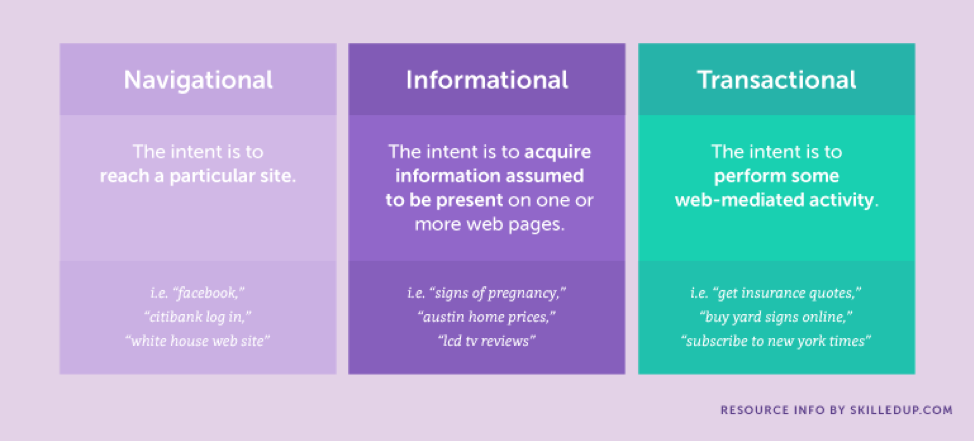
Here are deeper explanations of the search-intent types:
Informational intent – Searchers seek information. They want to find an answer to a question or a solution to a problem
Example: The bathroom sink is clogged. I perform a search to learn how to unclog a sink.
Navigational intent – Searchers seek a specific company or website. They don’t necessarily want to buy any of their products. They want help navigating to the site.
Example: Uncertain of my local bookstore URL, I search the name of the store and visit the site to find out the store hours.
Investigational intent – Searches with investigational intent hover between being informational and transactional in nature. People seek information to research future purchases and services they may want to buy, or companies they may want to buy from some day.
Example: I need a new pair of running shoes and want the best deal. I search types and brands to comparison shop and find the highest quality pair for the lowest price.
Transactional intent – Searchers are ready to buy. They search with keywords that are long-tail, specific, and intentional.
Example: I know the brand, color, and size of running shoes I need. I want to buy them and have them arrive by next week. I search for “Nike women’s Free RN Flyknit running shoes blue size 8” and find the best price and delivery time – and purchase the shoes.
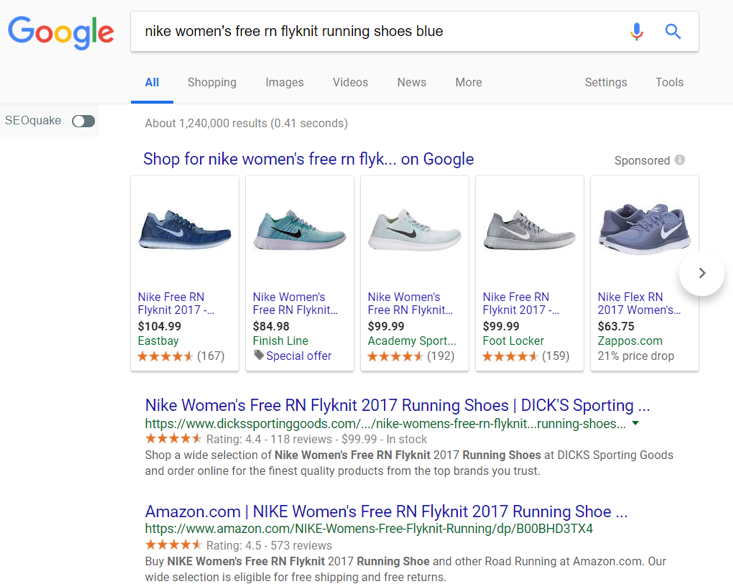
Target the keywords that hone in on the users’ search intent based on the action you want them to take. For example, if your goal is email list conversions, you might focus on informational intent searchers because they may discover you as a trusted source in your topic area. You might target keywords that begin with “how to” and ones that ask questions.Target keywords based on intent: informational, navigational, investigational or transactional. @JuliaEMcCoy Click To Tweet
Look at how This Old House targets users with informational search intent and encourages them to connect with home improvement professionals in their area:
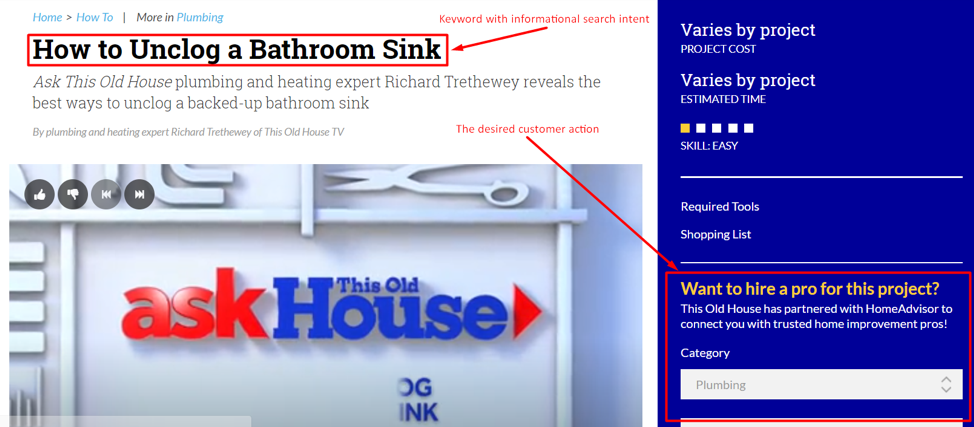
Bottom line: Help your content perform better and make sure you target the right keywords and search intent to achieve your goals.
HANDPICKED RELATED CONTENT:
2. Make your headlines irresistible AND helpful
High-performing content starts with a high-powered, irresistible headline that makes people want to read more.
You may have read about formulas and tools to help you craft headlines proven to perform better. But what about your headline’s usefulness factor?
Does your headline accurately describe the content piece and let readers know what they’re in for if they keep reading? Or does your headline use sneaky hyperbole and clickbait tactics to mislead readers?
Does your headline set up realistic expectations for the content? Or does it ultimately let your audience down?
Your content should build trust with the reader, but you can’t do that if you start with a headline that stretches the truth or neglects important information.You can’t build trust with readers if you use a misleading headline, says @JuliaEMcCoy. Read more>> Click To Tweet
Here’s an example of a clickbait headline that’s misleading:
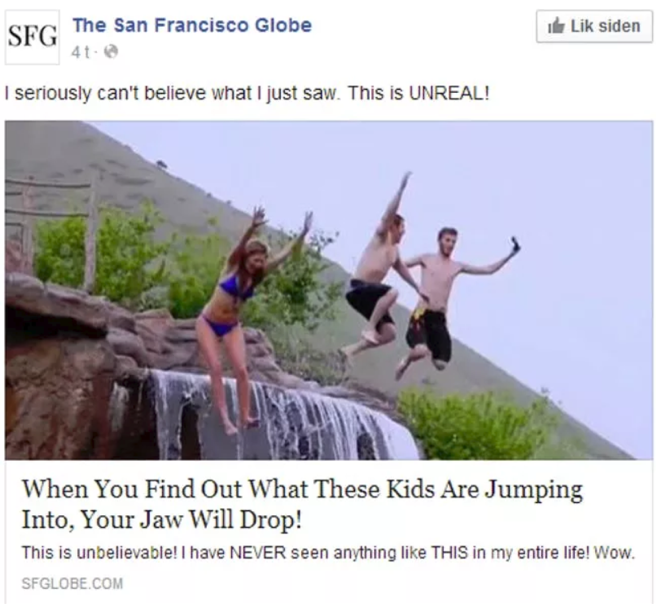
Is this jaw-dropping? No. Is the headline extremely misleading? Yes. The article reveals the kids are jumping into a swimming pool.
Here’s the interesting thing. Clickbait headlines don’t perform well. (Maybe this means people are catching on to the sneaky ways.) In a 2015 study, ReturnPath analyzed over 9 million headlines and subject lines and found that ones with common clickbait words performed below average as opposed to headlines focused on wording that emphasized benefits or urgency.Headlines w/ common clickbait words performed below average via @returnpath. Click To Tweet
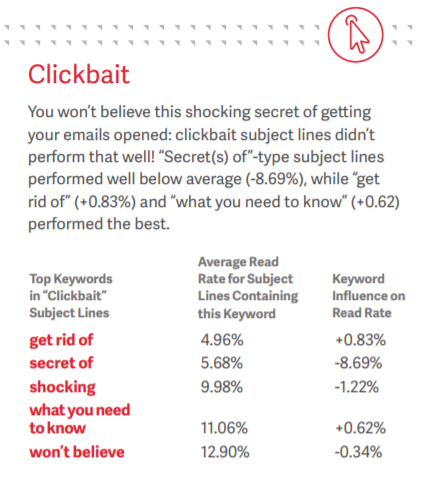
Compare the average read rate for headlines with clickbait keywords (the highest is nearly 13%) with the average read rate for headlines with words that connote benefits:
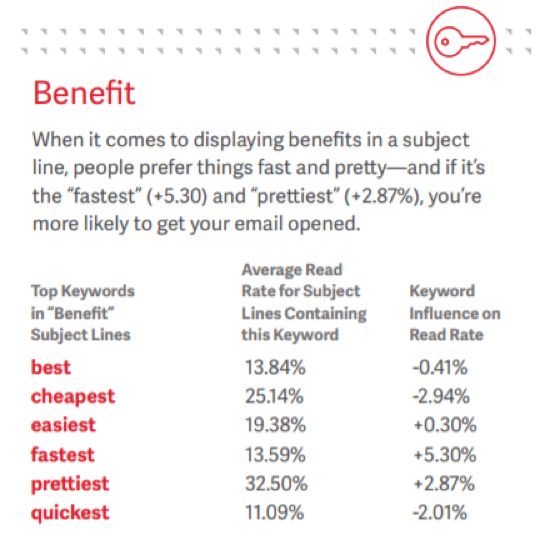
The average read rate is much higher, spanning from 11% up to almost 33%.
Bottom line: Use powerful wording to create irresistible headlines. Use formulas and tools to help you craft them, but don’t oversell your content or mislead people about the value it provides. Aim to be helpful and enticing for best results.Use powerful wording to create irresistible headlines, says @JuliaEMcCoy. Read more>> Click To Tweet
HANDPICKED RELATED CONTENT: How to Use Non-Obvious Thinking to Create Better Content
3. Improve your writing flow
After you hook ’em with your headline, what keeps readers moving through your content piece?
It’s a few things, but a big one is how well your writing flows. How well do you carry your readers along your content river? How easy is it to follow you from point to point, line to line, and paragraph to paragraph?
Plenty of content creators make their readers lose interest (or just plain get lost) along the way because they create unnecessary hurdles such as:
Paragraphs that are too long
Awkward paragraph breaks and split-up thoughts
Tone that is too formal or stilted
Content that loses sight of the audience (i.e., you get too technical or too simplistic)
Rambling without providing any value
Avoid these mistakes and aim to improve your flow.
For a primer on good writing flow, study blogs that consistently make you want to read to the end of every piece of content. Jon Morrow’s posts on Smartblogger flow expertly, taking readers through his content without even realizing they’re continuing to read:

Bottom line: Naturally guide your readers through your thought process, points, and information in a logical way – making them much more likely to complete a desirable action after they finish.
HANDPICKED RELATED CONTENT:
4. Include relevant, interesting images to illustrate your points
The power of images in your content should be blatantly obvious, given that we’re a visually oriented society.
BuzzSumo analyzed over 1 million articles to see how many with images were shared. Then it looked at the top shared ones to find telling trends.
Turns out, articles with images peppered in every 75 to 100 words got twice as many shares as articles with fewer images.Articles w/ images peppered in every 75 to 100 words got 2x the shares as articles w/ fewer images. @buzzsumo Click To Tweet
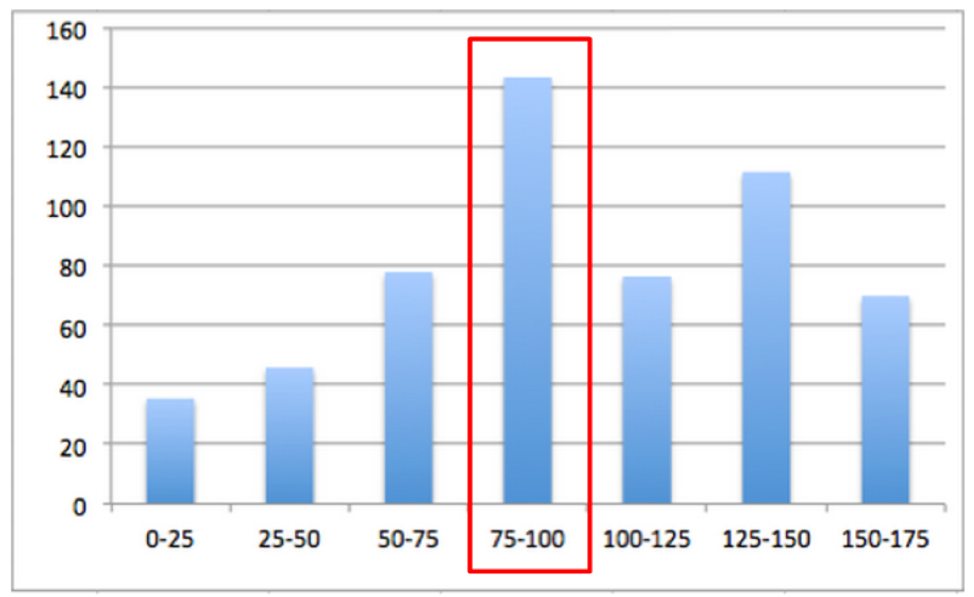
Include images throughout the body of your content that relate to and expand on the text. If you need inspiration, look at Neil Patel. He consistently creates content with examples, images, screenshots, and graphics to illustrate his points.
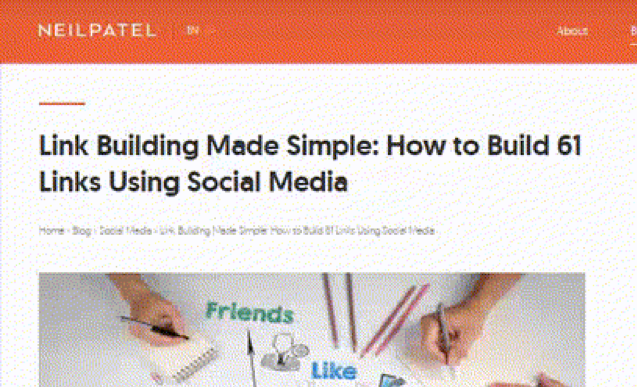
Bottom line: Provide relevant images that add context and illustrate your points. This not only makes your content more interesting, but also increases the chances that your readers will remember it.Using images to add context makes #content more interesting and memorable, says @JuliaEMcCoy. Click To Tweet
HANDPICKED RELATED CONTENT: 12 Types of Awesome Visual Content You Can Use in Your Blog Posts
5. Show the value immediately
If your readers can’t figure out why they should care within the first paragraph or two, they won’t. They’ll bounce from the page. If you waste time with an introduction full of fluff, your reader will click away to find another piece of content that gets to the point.
After you get their attention, tell them the topic, why they should care, and the main point you’re proving or explaining in the content. Remember, this isn’t high school composition. Throw the rules you learned there out the window and focus on writing to capture the attention of the average internet user.
Bottom line: Here’s a great example of an intro that works. It effectively grabs your attention and shows the value of the post immediately. Follow its lead and you’ll improve your content’s read rate as well as the length of time your reader stays on the page. Both add up to a better chance of converting.
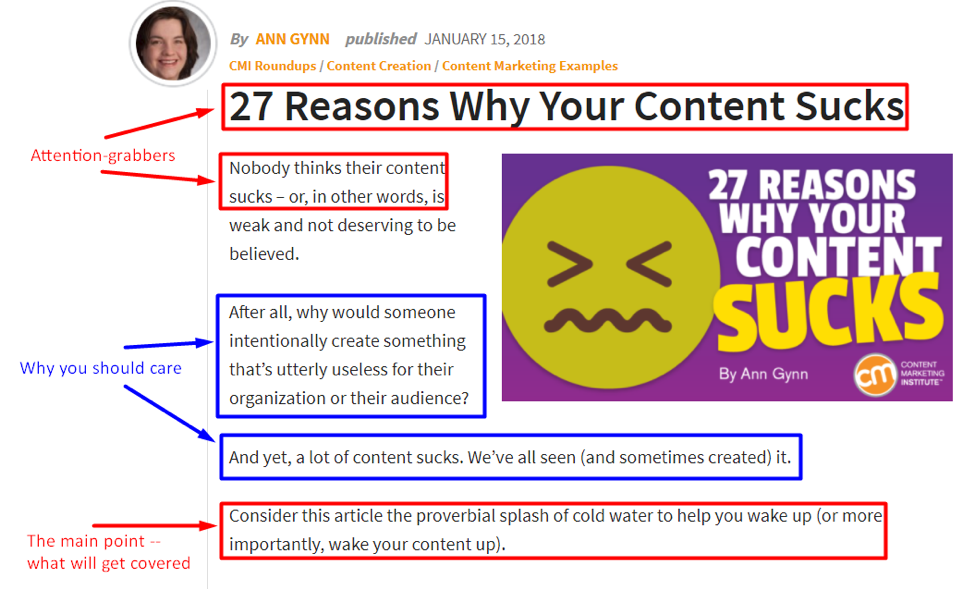
HANDPICKED RELATED CONTENT: An Editor’s Rant: 7 Questions Every Writer Should Be Asking
6. Create an utterly clickable CTA
High-performing online content ultimately inspires action. Of course, you can’t get readers to act unless you give them an opportunity. It should come in the form of a call to action – a link in your content that directs readers on what to do after they’re done reading.
CTAs come in many forms, but the best ones, the ones found in high-performing content, are utterly clickable:
They are tied into the content. Clicking the CTA should feel like a natural progression.
They use strong, persuasive wording (think powerful action verbs) that make readers want to click.
They are enticing –a graphic, a button, or linked action words in the CTA sentence.
This example from HubSpot accomplishes all of the above:

This CTA is related to the content, uses strong verbs (e.g., “download,” “learn”) and is enticing to click because it’s larger than the surrounding text, bolded, and in a color.
According to a HubSpot study, this anchor text CTA (a single line of text linked in the content) rakes in 47 to 93% of leads from posts where it appears. And, it works better when it shows up at various points in the content, not just at the end.
Bottom line: As you can see, a compelling, clickable CTA does a lot of work for a high-performing content piece. It’s the final push to get your readers to take that desirable action, so you need to make sure it counts.A compelling, clickable CTA is the final push to get readers to take desirable action, says @JuliaEMcCoy. Click To Tweet
HANDPICKED RELATED CONTENT: Words That Convert: Test, Learn, Repeat
Put all the puzzle pieces together
High-performing content doesn’t have one or two standout factors. Instead, it has many pieces that each contribute to its success – shares, conversions, sign-ups, or some other desirable reader action.
Think of it this way: A piece with a fantastic headline is nothing without a solid intro and value-added content. The first part grabs readers, the second keeps them on the page, and the third nurtures them, warming them up for the irresistible CTA.
You need each piece to inspire action and get results. Once you have all of them in place, your content should perform better than you ever dreamed.
HANDPICKED RELATED CONTENT: Road Map to Success: Creating the Content of Your Audience’s Dreams
Crafting content is both an art and a science. Learn more about each side of the practice at Content Marketing World Sept. 4-7. Register today using code BLOG100 to save $100.
Cover image by Joseph Kalinowski/Content Marketing Institute








Comments